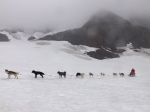
Sled dog teams and their mushers recently crossed the Iditarod finish line in Nome completing a nearly 1000 mile journey across Alaska. Being pulled by running dogs with my hair flying in the breeze has been a dream of mine since the age of 8 when I thought it was a good idea to take our old English sheepdog out for a walk while wearing roller skates. For the record, it was not a good idea. Since that failed attempt to harness the power of a running dog, I thought a less injurious way to get that same sensation would be to try dog sledding. On our trip to Alaska, it was time to make that dream come true.
After researching various options for dog sledding, I quickly came to realize that during the summer, most dog sledding excursions use a wheeled sled. In my own crude way, I had already experienced the “joy” of being pulled along on wheels. I wanted the authentic experience of dog sledding on snow. The only way to do that in August would be to take a helicopter up to a glacier.
As soon as the helicopter cleared the ridge of the mountain, we were instantly transported to winter. The fact that it was foggy, drizzling and cold helped set the mood. During the summer months, the dogs are kept on the glacier so that they can continue their training. With 60 plastic, igloo-shaped dog houses clustered together, the glacier looked like doggy summer camp. Oregano and I expected the auditory assault of collective barking as soon as we landed, but the only sound we heard was from the rotors of the helicopter. Once it flew away, it was eerily quiet.
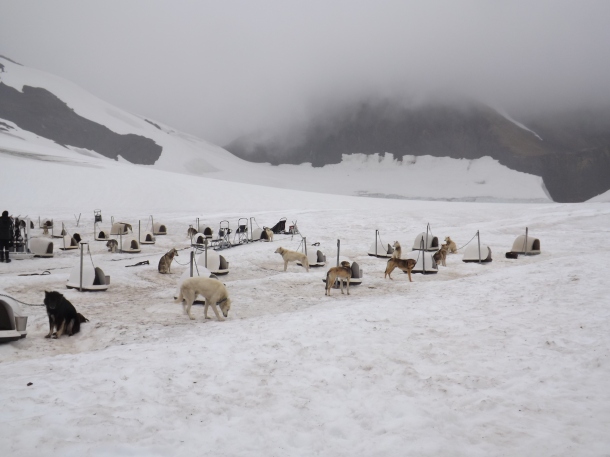
Doggy summer camp on the glacier
The mushers introduced themselves then gave us the history of dog sledding in Alaska. They explained the different breeds of dogs used, how the dogs must be fed and cared for during training and during a race. Because they run such long distances when racing, the mushers must put booties on each dog’s paws to protect them. If you’ve ever tried to put socks on a wriggling toddler you have some appreciation for what these mushers must do. Now imagine trying to accomplish this task on sixteen four-legged, wriggling toddlers while your hands are freezing cold. We had no idea how much was involved in running a dog sled race. It was fascinating.
As the mushers patiently answered all of our questions, their assistants got the sleds out. Instantly, the calm erupted into a canine cacophony.
“The dogs LOVE to run,“ the musher yelled so we could hear him over the barking. “They know what the sound of the sleds means.”
Some of the dogs were standing on top of their igloos barking and howling. Their behavior reminded me of students in class yelling, “Pick me! Pick me!” Very quickly, the assistants selected the lucky winners who would get to go for a run and hooked them into position.
While the dogs were being harnessed, Mike the musher showed us the sleds. They are very light aluminum. The Flexible Flyer I used to sled down hills on the golf course after a snowstorm seemed a whole lot sturdier than the sleds they use to traverse Alaskan terrain. At the back of the sled are narrow rails on which the musher must stand to balance himself and control the sled. Between those rails is a flap of plastic they push down on the snow to cause drag and slow the sled. There is a small metal anchor that acts as a brake. 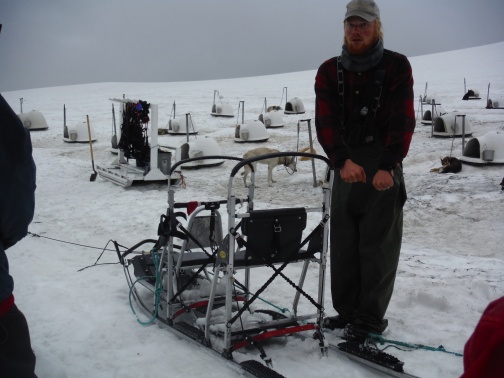
Mike got us situated on the sled. I sat on a seat at the front. If I’m being honest, seat is a generous term for what I was actually sitting on. It was more like a butt-sized plank with a tiny bit of cushioning and handles on either side. Oregano stood behind me. The musher got on the rails all the way at the back and the assistant lifted the brake. Without the anchor holding them back, the dogs that had been straining against their harnesses began running. It was like being shot out of a cannon. I had always imagined it would be more of a gentle increase in speed. Not so.
From a distance, the dog sled looks like it glides smoothly. As we bounced and bumped over the uneven snow and ice with the sled sometimes listing to one side, I was disabused of that romantic notion. I grabbed onto the handles on the sides of my tiny seat and held on tight.
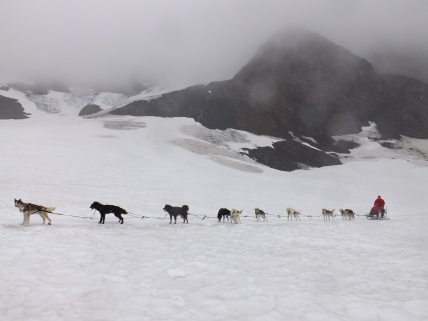
This was soooooo much more fun than being pulled by my dog while wearing roller skates.
Mike mushed us around to the far side of the glacier and threw the brake in the snow. He complimented us for not flying off the sled. Apparently, many dog sledding newbies are easily tossed from the sleds when they first leave the camp. He snapped a few commemorative photos then he told us it was our turn to drive. He showed us the proper stance, how to steer and had us put our feet on the narrow metal runners. Braver than me, Oregano opted to drive first. As we were flying over the snow, I noticed cylindrical brown projectiles hurtling past me to the left and right. I thought it was another unexpected hazard of dog sledding; rocks being kicked up by the dogs. As I looked around the mountain and the pristine snow of the glacier taking a moment to absorb where I was and what I was doing, it dawned on me that there aren’t rocks on top of the snow on a glacier. It wasn’t until I saw the “rocks” falling out of the business ends of the dogs in front of me that I realized it was flying feces. To my amazement, the dogs were shitting as they ran at full speed. There was no stopping to sniff around to select the perfect location. There was no spinning in place until just the right moment in time. These pups didn’t even break stride to poop. As a member of a species that sits and remains stationary to defecate, I was truly impressed by the dogs’ stamina and agility. The most I’ve ever accomplished while pooping was finishing a chapter of a book.
Oregano was driving at the back of the sled presumably trying not to fall off. I doubt he noticed the miracle of nature I was witnessing from my front row seat. Since the real musher was standing just behind me, I tilted my head back towards him, “Are those dogs really shitting while they’re running?” He could hear the awe in my voice.
“Yep,” the musher laughed at me. “We have 16 dogs on the team. We can’t stop running the race because one of them needs to pee or poop. We’d never get anywhere.”
As I bounced along the glacier with dung being flung past either side of my seat, I had a much deeper understanding of the axiom, “It’s good to be the lead dog.”

The reason it is good to be the lead dog…


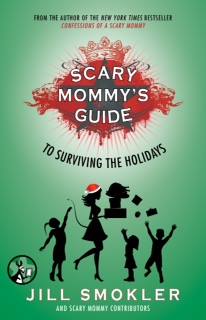

What’s the big deal? Politicians have been doing this for decades….
But not while running on four legs in snow…
Hahaahaha! Great post…I’m in awe of your bucket list!
>
Glad it made you laugh! I know I’ve got a few people living vicariously through my bucket list. It’s a lot of pressure, but someone has to do it.
I’m glad golf carts were invented. I’d hate to think of a bunch of $$%%%ing dogs pulling me and my clubs around. My game is crappy enough.
Dog sledding on a golf course is an interesting idea. Might be hard to find your golf ball in the snow.
Another great story. You were probably “pooped” at the end of the day 🙂 couldn’t help it…
I don’t remember your Old English Sheepdog though. What was the name?
We were definitely “pooped” by the end of the day.
The sheepdog’s name was Teddy. He was more like a billy goat than a dog.
Just judging by that last photo… Luckily the harness & traces are angled to deflect (anything/everything): to the outside? LOL!
Maybe they should put a splatter shield on the front of the sled 🙂
Another great post! How fun! Good job dodging flying poop!!
I’m not so sure I did anything to dodge the poop. I’m thinking that was just dumb luck.